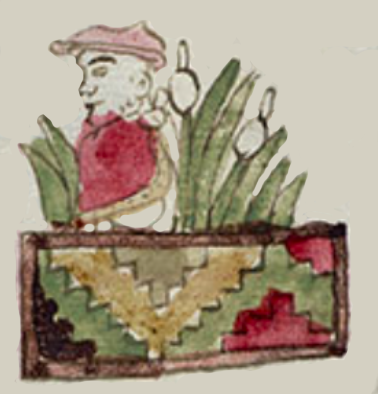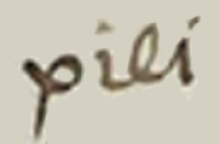pilli (CST33)
This painting of the simplex glyph for the term pilli (nobleman) shows a man seated next to tules on top of a rectangle with what may be a stepped fret design. This is the place glyph for Mexico City. His name is Francisco Sánchez (a Spanish name taken by a Mixtec local member of the elite). He is shown in profile facing the viewer’s left. He wears a pink hat and a red cape with gold trim tied at the shoulder. His bottom is bare (although there could well be a loincloth that is not visible). The companion text explains that this pilli from Texupan and some other pipiltin (plural, noblement) went to Mexico City. They were there a “long time,” and they consumed a lot of food, for the bill was 30 pesos.
Stephanie Wood
For more on the Codex Sierra, see Kevin Terraciano’s study (2021). See especially pp 120 and 155, for the transcription of the Nahuatl and its translation to English.
Stephanie Wood
1550–1564
Jeff Haskett-Wood
México, nobles, topónimos

pil(li), a nobleman, https://nahuatl.wired-humanities.org/content/pilli
un noble
Stephanie Wood
Códice Sierra-Texupan, plate 33, page dated 1560. Origin: Santa Catalina Texupan, Mixteca Alta, State of Oaxaca. Kevin Terraciano has published an outstanding study of this manuscript (Codex Sierra, 2021), and in his book he refers to alphabetic and “pictorial” writing, not hieroglyphic writing. We are still counting some of the imagery from this source as hieroglyphic writing, but we are also including examples of “iconography” where the images verge on European style illustrations or scenes showing activities. We have this iconography category so that such images can be fruitfully compared with hieroglyphs. Hieroglyphic writing was evolving as a result of the influence of European illustrations, and even alphabetic writing impacted it.
https://bidilaf.buap.mx/objeto.xql?id=48281&busqueda=Texupan&action=search
The Biblioteca Digital Lafragua of the Biblioteca Histórica José María Lafragua in Puebla, Mexico, publishes this Códice Sierra-Texupan, 1550–1564 (62pp., 30.7 x 21.8 cm.), referring to it as being in the “Public Domain.” This image is published here under a Creative Commons license, asking that you cite the Biblioteca Digital Lafragua and this Visual Lexicon of Aztec Hieroglyphs.



